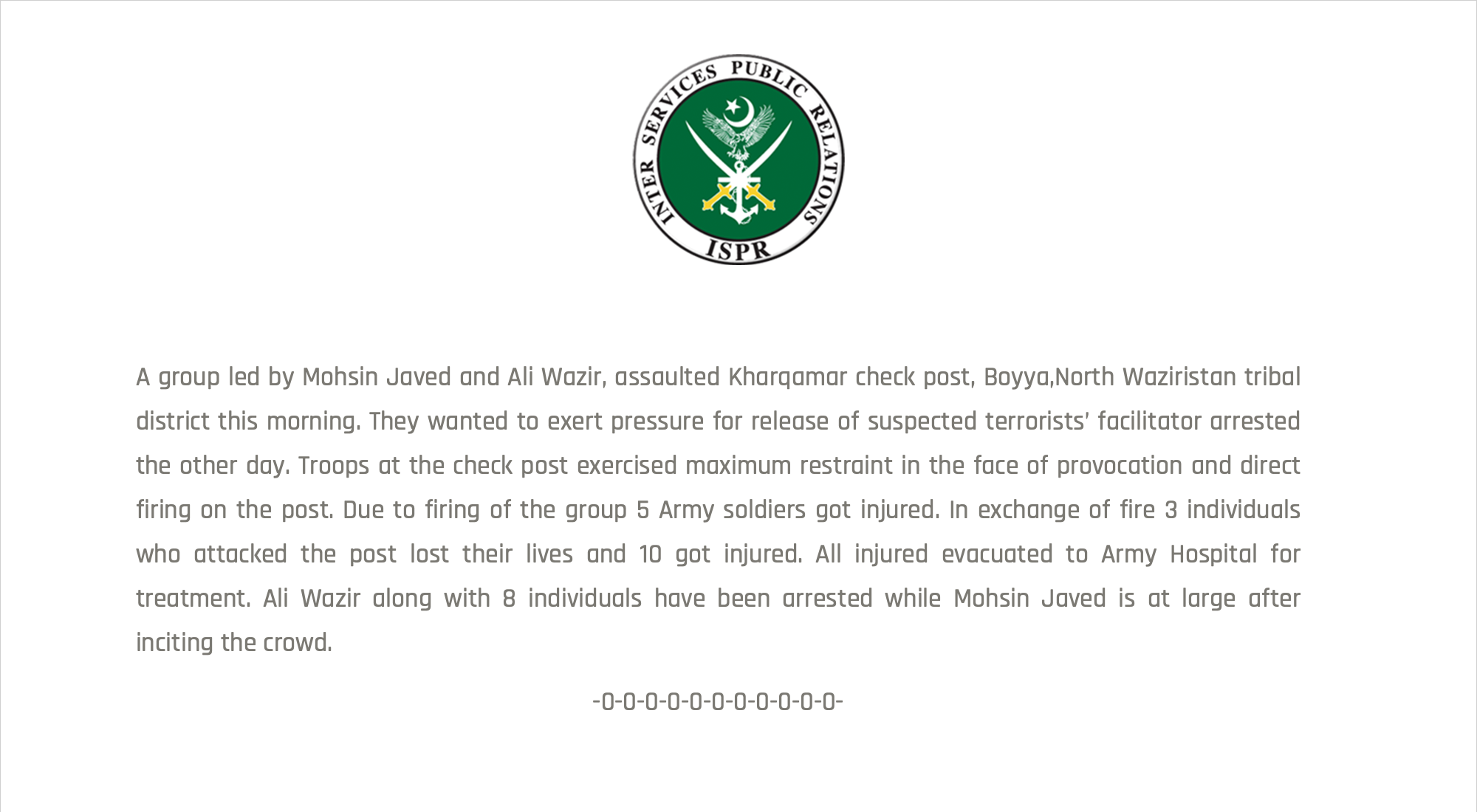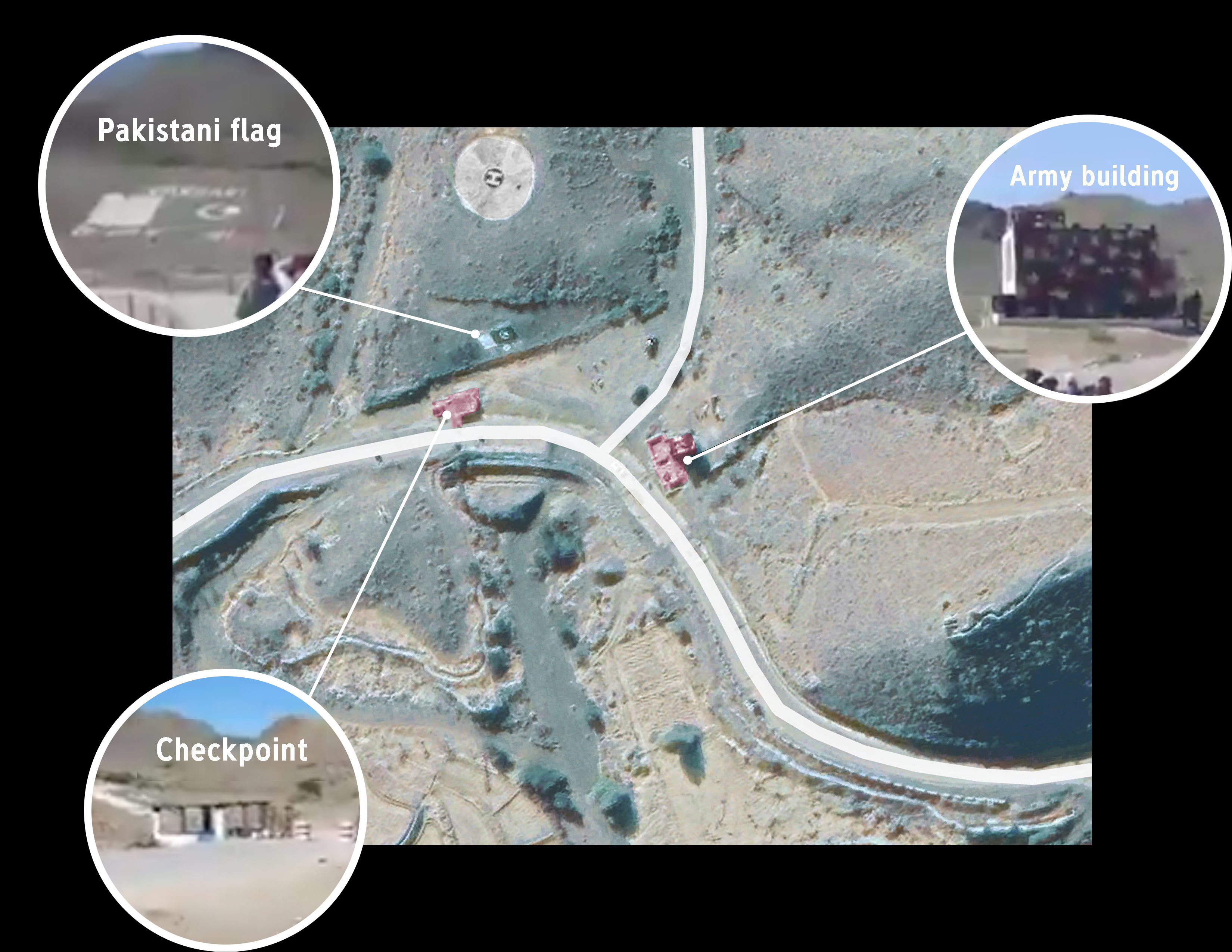
May 26, 2019 Around 9 a.m.
95° F
A group of protesters approached an army checkpoint in the mountains near Boyya, a town in the North Waziristan region of Pakistan.
The checkpoint is in an isolated area, approximately 10 miles from the Afghanistan border. It was Ramadan, so many of the protesters were fasting, and the temperature was hovering around 95 degrees fahrenheit.
Among them were two parliamentarians, Ali Wazir and Mohsin Dawar, and the local tribal chief of a nearby town called Doga Macha Madakhel, where days earlier a military operation had left an elderly Pashtun woman with a broken arm, according to a Human Rights Commission of Pakistan report.
Pashtuns are an ethnic minority group but make up the majority of residents in Pakistan’s northern tribal districts.
Due to their proximity with Afghanistan, the districts have been used by militant groups, including Al Qaeda and the Taliban, for the past two decades. This has made them the target of several military operations by Pakistan's armed forces.
“The Pashtuns have suffered tremendously at the hands of the military because of these efforts against terrorism that have entailed scorched-earth campaigns that have targeted civilians in a big way,” said Michael Kugelman, the deputy director of the Asia Program and South Asia senior associate at The Wilson Center. “Innocent Pashtuns have been caught up in the dragnet of these Pakistani state efforts to go after terrorists.”
The military operations have damaged homes, schools and hospitals; displaced millions of people; and left behind landmines. Meanwhile, government support for Pashtuns has been mismanaged, according to the HRCP.

In January 2018, the Karachi police killing of a Pashtun shopkeeper, Naqeebullah Mehsud, seeded a grassroots movement – the Pashtun Tahaffuz Movement, or PTM – hoping to raise awareness about military abuse and advocate on behalf of Pashtuns.
By early 2019, after several days-long protests in Islamabad, the nation’s capital, tensions between PTM and the government, of which Wazir and Dawar are members, had reached an all-time high. What was meant to be another peaceful protest at the Kharqamar checkpoint in May, turned deadly.
“The emotions and the temperature were very high,” Dawar told us when we spoke to him recently.
He recalled a group of roughly 300 protesters moving slowly down the road towards the checkpoint, where two barriers were set up. Some of the protesers were allowed to pass the first barrier, or had left the road to move around it, he said, but most were stalled and became frustrated with the 10 to 15 soldiers blocking their path.
Members of the army responded with anger, too, Dawar said, hurling abuse at him as he moved towards the second barrier. He soon heard gunshots behind him.
“When people started falling on my left and right, when I saw the blood on their bodies … I realized they had started firing straight on us,” Dawar said.
Dawar remembered falling down then being shepherded across the bridge in front of the checkpoint by protesters and sheltering in a nearby shop.
“They kept firing until there was nobody left,” he said. “Whoever tried to move, they fired. And we waited.”
At least 13 PTM protesters were killed, though Dawar said two more later died in hospital, and several others were arrested and taken to nearby jails without charge.
Dawar was arrested, too, along with Wazir, and the politicians were eventually transferred to Haripur, a high-security prison for terrorists and other dangerous criminals, overseen by the army and intelligence agencies, rather than the civilian administration.
“When people started falling on my left and right, when I saw the blood on their bodies … I realized they had started firing straight on us.”
A report by the HRCP labeled the arrests of the two National Assembly representatives “extremely disturbing”. It cited allegations that the army and chief minister offered financial compensation to the families of the dead, apparently on the condition they agreed to state that Dawar and Wazir incited the crowd to protest that day.
“Everybody refused to give any such kind of statement,” Dawar said.
The army disputed the protesters’ account, claiming they had fired on the checkpoint first. The Inter Services Public Relations Pakistan, the army’s press service, released a statement on May 26, 2019, accusing the politicians of inciting a mob to attack the soldiers, who, it argued, had “exercised maximum restraint”.

In one of the videos shared on social media, a man can be heard saying that around 25 people were shot and taken away on chairpois – a type of bed made from woven rope. A boy on such a bed later appears in the video, apparently injured.
The man adds, “They are not accepting our pleas that it is an emergency and to let us take them for treatment.” He then says the shooting took place in the presence of two parliamentarians and that “we are not allowed to have a peaceful protest in Waziristan.”

“If the reports are correct that the army killed protesters by unlawfully using live ammunition, this would be a very serious violation of international law,” wrote Rabia Mehmood, a researcher at Amnesty International, the day after the incident.
“Under international law, lethal force can only ever be used by law enforcement authorities when strictly necessary to protect life.”
In the lead up to the Kharqamar incident, Pakistani authorities had intensified their crackdown on PTM, arresting, arbitrarily detaining, monitoring, and threatening the group's supporters, according to Amnesty International.
“Under international law, lethal force can only ever be used by law enforcement authorities when strictly necessary to protect life.”
In February 2019, Arman Luni, a PTM activist from Baluchistan, was allegedly murdered by police while in custody.
“Ethnic minorities in Pakistan frequently don't have it easy,” said Kugelman, who added that until recently Pashtuns “didn’t have strong voices to advocate on their behalf”.
PTM has provided a crucial and unprecedented platform for Pashtuns, while also applying scrutiny to Pakistan’s secretive military and intelligence services.
“It clearly is one of the many reasons why the PTM is so controversial and unpopular in many ways in Pakistan, because it's so unusual for the military to be reamed out like that,” Kugelman said. “But I think that’s important to democracy.”
Kugelman explained that the backlash against the PTM is, at least in part, due to its leaders' outspoken, sometimes charged criticism of the state, which has led to a concerted campaign to deny the movement airtime in the national media, as well as the extrajudicial arrests of some PTM leaders.
“PTM has very principled, passionate stances on issues, because the people in this group are understandably aggrieved and angry, given how they and their communities have been treated.”
The silencing of PTM also reflects the state’s broader efforts to crack down on dissidents, which has recently gained attention in the international media.
“PTM has very principled, passionate stances on issues, because the people in this group are understandably aggrieved and angry, given how they and their communities have been treated,” Kugelman said.
In some ways the Kharqamar Incident showed the fragility of the movement, which is unlikely to be able to build widespread popular support within Pakistan, Kugelman explained, but it also showed its resilience. “It may be down, but it's certainly not out.”